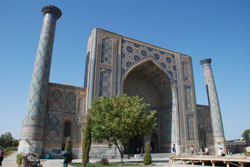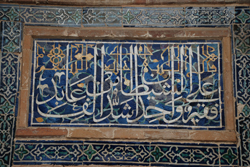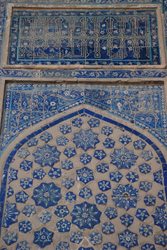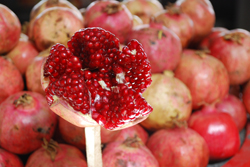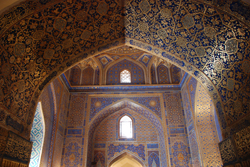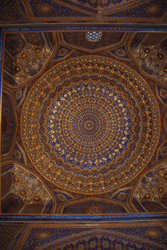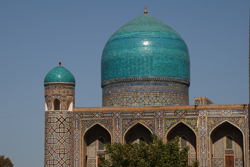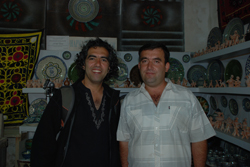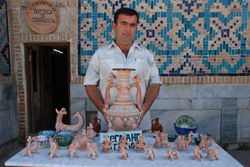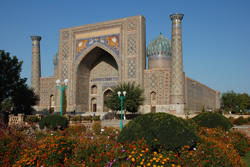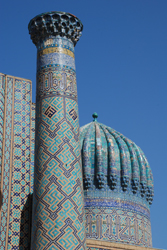Samarkand: Reveling in Registan
6 October, 2008, 04:44 am in "Uzbekistan"
All the photos I've seen and stories I've read didn't prepare me for Samarkand. Or maybe its man-made beauty shocked me since for the past couple months we've been in places of natural beauty but lacking an abundance of historic beautiful sites. This morning was devoted to visiting Registan. Although surrounded by more modern city structures, the buildings of the Registan still dwarf them. This impressive threesome of medressas dominate the part of town we are in with turquoise domes, tiled faces and minarets. The beige bricks of the buildings are adorned with turquoise, blue, green and white tiles. The tile work has fascinating designs and patterns, flowers become stars, and swirls become flowers. The brick and tiles harmoniously shine against the light blue sky. Columns soar with ornate tiled crowns. Everywhere there are patterns but the effect is calming rather than clashing.
In the courtyard, surrounded on 3 sides by these medressas (schools) it is hard to decide where to look first. I chose Ulugbek's. It has 2 beautiful minarets with tile brick patterns which direct the eye upward to its tiled calligraphy and geometrical “stalactite” capitals (muqama). The “body” of the building is solid and rectangular. Mostly it is decorated with brick tile patterns but pointed arches add curves and serve as the base for ornate swirled vines and flower tile work.
In the courtyard, surrounded on 3 sides by these medressas (schools) it is hard to decide where to look first. I chose Ulugbek's. It has 2 beautiful minarets with tile brick patterns which direct the eye upward to its tiled calligraphy and geometrical “stalactite” capitals (muqama). The “body” of the building is solid and rectangular. Mostly it is decorated with brick tile patterns but pointed arches add curves and serve as the base for ornate swirled vines and flower tile work.
The architect was Kavomidden Sherozi whose name means he was from Shiraz. Looking at these buildings devoted to science and seeing the skillful craftsmanship really makes one see what an amazing place Samarkand must have been in its heyday.
The central entrance section (Iwan), is where the simpler patterns give way to a riot of ornamentation and an incredible variety of tile work. Gardens of stars, flowers, and filigree blossom from the walls. Some are cut tiles, other glazed patterns on tile. The top is a beautiful section of star patterns merging into flowers, contrasting colors of glazed work against patterned terracotta. A geometric patterned window grate reveals the courtyard, baring you from what's inside but giving one the feeling of glimpsing into a secret place.
One thing that impressed me about the architecture and decoration is the division of space. It is as if the architecture is dividing the world of patterns into manageable spaces. There seems to be something philosophical about it-- presenting different ideas, a balance between sensible grounded brick tiles and poetic vines and flowers finding the parts that make a whole. At eye level, the tile-work was broken by a strip of calligraphy carved into marble and below that was simple geometric designs in blue tile.
The inside courtyard had four doorways and numerous rooms surrounded it. Above the door of each was a passage in Arabic. Rowshan translated one, “Gain science in this world for the next.” Unfortunately, the rooms had been made into souvenir shops with sellers badgering us to come inside making it difficult to peacefully soak in the beauty of the designs.
The central entrance section (Iwan), is where the simpler patterns give way to a riot of ornamentation and an incredible variety of tile work. Gardens of stars, flowers, and filigree blossom from the walls. Some are cut tiles, other glazed patterns on tile. The top is a beautiful section of star patterns merging into flowers, contrasting colors of glazed work against patterned terracotta. A geometric patterned window grate reveals the courtyard, baring you from what's inside but giving one the feeling of glimpsing into a secret place.
One thing that impressed me about the architecture and decoration is the division of space. It is as if the architecture is dividing the world of patterns into manageable spaces. There seems to be something philosophical about it-- presenting different ideas, a balance between sensible grounded brick tiles and poetic vines and flowers finding the parts that make a whole. At eye level, the tile-work was broken by a strip of calligraphy carved into marble and below that was simple geometric designs in blue tile.
The inside courtyard had four doorways and numerous rooms surrounded it. Above the door of each was a passage in Arabic. Rowshan translated one, “Gain science in this world for the next.” Unfortunately, the rooms had been made into souvenir shops with sellers badgering us to come inside making it difficult to peacefully soak in the beauty of the designs.
In the courtyard I was struck by the calming and cooling feeling which radiated from the tiles from the cool colors: blues, greens, turquoises. One type of tile-work patterns repeated in the doorways reminded me of blue and white snowflakes. A cool oasis in the desert.
One woman who was trying to get us into her shop told another seller in Tajik Rowshan was a tourist. Rowshan responded that he wasn't. “Look around! Everything is Persian.” He challenged her to read the writing above her shop. When she acknowledged that she couldn't read it, he asked, “Who is the tourist?” and she said, “I am.”
My first impression of the Tilla Kori Medressa (built 1646-1660 during the reign of Yalangtush Bakhodir) was it was more down to earth with simpler tile work than the other medressas. It was only 1 story. Then we walked into the mosque. It was redolent of gold, white, and blue filigree rising to intricate leaves and vines which create an optical illusion of a domed roof. It was the Baroque or Rococo equivalent in Islamic Architecture.
My first impression of the Tilla Kori Medressa (built 1646-1660 during the reign of Yalangtush Bakhodir) was it was more down to earth with simpler tile work than the other medressas. It was only 1 story. Then we walked into the mosque. It was redolent of gold, white, and blue filigree rising to intricate leaves and vines which create an optical illusion of a domed roof. It was the Baroque or Rococo equivalent in Islamic Architecture.
It one wing was a museum with interesting old photos of monuments around town before restoration. On a return visit, Rowshan found the restorers had made a mistake on the painted interior painting several Arabic calligraphic pieces backwards. We also learned the Soviet restorers had added domes to the main structure and its minarets.
In the museum was a short paragraph on the history of the site. Ulugbek's 15th century constructions were the medressa, Khonako, a caravansaray, two mosques (Mukatta and Kukaldosh. In the 17th century, Yalangtush Bahodur built the Medressa Sherdor on the ruined Khanako and the Tilla Kori Madressa on the ruins of the caravansaray.
In the courtyard of Tilla Kori we saw a ceramics workshop. We are a little skeptical of these “workshops” because most seem to just be souvenir stores. We were surprised, however, to find an actual artist in the ceramics workshop. He was very gracious and when he learned Rowshan was also a ceramics artist, he told him about the different styles in his shop, about the processes used and unlocked the next cell over and showed Rowshan the kiln he'd made. Among the pieces he had for sale were “suzan” designs from Rishtan--solid colored pieces with tezhip designs carved into the pigment with a needle, Green and blue Rishtan pieces with blue and green designs, and his own work-- whimsical figurines of white beards, camels, and dragons as well as Samarkand style bowls with designs etched in and tinted sections of transparent colored glazes.
In the courtyard of Tilla Kori we saw a ceramics workshop. We are a little skeptical of these “workshops” because most seem to just be souvenir stores. We were surprised, however, to find an actual artist in the ceramics workshop. He was very gracious and when he learned Rowshan was also a ceramics artist, he told him about the different styles in his shop, about the processes used and unlocked the next cell over and showed Rowshan the kiln he'd made. Among the pieces he had for sale were “suzan” designs from Rishtan--solid colored pieces with tezhip designs carved into the pigment with a needle, Green and blue Rishtan pieces with blue and green designs, and his own work-- whimsical figurines of white beards, camels, and dragons as well as Samarkand style bowls with designs etched in and tinted sections of transparent colored glazes.
The 3rd Medressa, Sher Dor's striking features include some odd tile lions (that look like tigers) with a sun rising behind with a rather cartoonish looking face. It looks like they are working on restoring the main arch tile work. Another striking feature is the turquoise fluted, tiled domes.
Inside were (surprise surprise!) souvenir shops. One did have musical instruments including dafs, a “chang” (santour), and lots of rebabs.
I'm sitting in the area across from the Tillya Kori Madressa thinking how beautiful the tile-work looks from a distance-- like blue and tan lace. The tile-work of Tillya Kori which from close-up seemed heavy from a distance becomes light filigree. Unfortunately, there are a lot of aggressive beggars-- women and children who attach themselves onto you. Rowshan had to laugh when he noticed a beggar woman pulled out her cell phone to take a call. I guess everyone has cell phones these days.
I'm sitting in the area across from the Tillya Kori Madressa thinking how beautiful the tile-work looks from a distance-- like blue and tan lace. The tile-work of Tillya Kori which from close-up seemed heavy from a distance becomes light filigree. Unfortunately, there are a lot of aggressive beggars-- women and children who attach themselves onto you. Rowshan had to laugh when he noticed a beggar woman pulled out her cell phone to take a call. I guess everyone has cell phones these days.
[ View 1 Comments
|
]
Comments
michelle tavakoli -
posted on 3/23/2009
THESE BUILDINGS ARE SO AWE INSPIRING AND HOW DID THEY DO THE PAINTING ON THE HUGE OUTSIDE COLUMS OF THESE MOSQUES/MEDESSAS? WHY IS IT ARCHITECTURE HERE SO .....BLAH BLAH SNORING/BORING UGLY MODERN? I LOVE THE OLDER THE BETTER IN ASIA/EUROPE/MIDDLE EAST
Powered by My Blog 1.69. Copyright 2003-2006 FuzzyMonkey.net.
Created by the scripting wizards at FuzzyMonkey.net..
(Code modified by Rowshan Dowlatabadi)
Created by the scripting wizards at FuzzyMonkey.net..
(Code modified by Rowshan Dowlatabadi)



